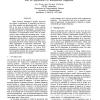Free Online Productivity Tools
i2Speak
i2Symbol
i2OCR
iTex2Img
iWeb2Print
iWeb2Shot
i2Type
iPdf2Split
iPdf2Merge
i2Bopomofo
i2Arabic
i2Style
i2Image
i2PDF
iLatex2Rtf
Sci2ools
IJCAI
1989
1989
A Computational Framework for Granularity and its Application to Educational Diagnosis
Many artificial intelligence systems implicitly use notions of granularity in reasoning, but there is very little research into granularity itself. An exception is the work of Hobbs [1985], which outlines several characteristics of granularity. In this paper we describe an approach to representing granularity which formalizes in computational terms most of Hobbs' notions, often refining and extending them. In particular two types of granularity have been delineated: ion and abstraction. Objects can be described at various grain sizes and connected together into a granularity hierarchy which allows focus shifts along ggregation or abstraction dimensions. We briefly discuss how we have used granularity hierarchies in the recognition of novice LISP programming strategies and show how this enhances the recognition process and can lead toward planning appropriate feedback for the student.
| Added | 07 Nov 2010 |
| Updated | 07 Nov 2010 |
| Type | Conference |
| Year | 1989 |
| Where | IJCAI |
| Authors | Jim E. Greer, Gordon I. McCalla |
Comments (0)

